 sponsored by
sponsored by



By SCOTT FYBUSH
Well, that was a year few of us in radio or TV would
care to repeat, wasn't it?
It started with some of the most brutal layoffs the industry
has ever seen and ended with the bankruptcy of one of radio's
biggest players - and somewhere along the way we lost Paul Harvey
and Walter Cronkite and Larry Glick and Paul Sidney.
New formats and new talent were in short supply on radio -
and no sooner did analog TV go dark in the U.S. than digital
TV was being declared outmoded, too.
But maybe someday we'll look back on 2009 and find something
of value amidst the rubble...and in any event, we embark on our
15th annual Year in Review as we always do, with our Top Ten
Stories of the Year:
1. The economy hits the skids
Choosing this year's top story was an easy call: there was
nobody anywhere up and down the broadcasting food chain who ended
2009 without being battered by one of the worst years in recent
media history.
None of the big groups escaped the carnage, starting with
massive hits on New Year's Eve at CBS Radio's WBZ in Boston and
WTIC in Hartford and continuing a few weeks later with a huge
reduction in staffing across the region's Clear Channel clusters,
eclipsing a smaller (but still painful) set of cutbacks in Citadel
markets such as Providence and Buffalo.
Greater Media swung its axe in Boston at the end of January,
and smaller groups weren't immune, either, as the month's end
found veterans such as Samantha Stevens, late of Cox in Bridgeport,
and Steve Cormier, late of Vox in Burlington, out of work.
February dawned just as dark, with cuts at Cumulus clusters
around the region - and then the pain moved to TV as consolidation
began to wipe out newsrooms on both sides of the border. (More
on that in a moment.)
Beyond the immediate impact of the job cuts (the pace of which,
thankfully, began to slow down after the first few months of
2009), the lingering economic malaise was being felt by radio's
dealmakers, who found it all but impossible to line up the credit
that might otherwise have allowed some willing buyers to take
advantage of the retreat from the unsustainably high prices that
broadcast licenses had been commanding in recent years.
 Nassau Broadcasting
provided perhaps the year's best case study when it had to abandon
its LMA-to-buy deal at WFKB (107.5 Boyertown PA) at the end of
March, walking away from the "Frank" classic hits format
it had installed and returning the station to its former WBYN-FM
calls and religious format. That was just the start of Nassau's
troubles in 2009; by year's end, the company's lenders at Goldman
Sachs had taken control of what was left of the company, selling
off some of its once-prized properties, such as WCRB in Boston,
at a steep discount from the prices Nassau had paid for those
signals at the top of the market. Nassau Broadcasting
provided perhaps the year's best case study when it had to abandon
its LMA-to-buy deal at WFKB (107.5 Boyertown PA) at the end of
March, walking away from the "Frank" classic hits format
it had installed and returning the station to its former WBYN-FM
calls and religious format. That was just the start of Nassau's
troubles in 2009; by year's end, the company's lenders at Goldman
Sachs had taken control of what was left of the company, selling
off some of its once-prized properties, such as WCRB in Boston,
at a steep discount from the prices Nassau had paid for those
signals at the top of the market.
Clear Channel went through another round of job cuts in May,
replacing local talent in some markets with "Premium Choice"
voicetracking - and that, thankfully, proved to be the last of
the year's mass layoffs on the U.S. side of the border, though
our colleagues in Canada had to live through cuts at several
big groups, most notably Astral Media, later in the summer.
As summer turned to fall, the news got a little better, at
least for a few smaller owners. In central New York, for instance,
James Johnson's new Leatherstocking group entered first Oneida
and then the much larger Syracuse market nearby, where Craig
Fox and Sam Furco were also able to use the decline in station
values to buy back - at a steep discount - the 105.1 signal they
sold to Clear Channel eight years ago. Down on Long Island John
Caracciolo and Vic Latino found financing for the $2.7 million
purchase of two of Jarad Media's stations, parlaying that deal
into an approach into the New York City market (more on that
in a bit, too.) Connecticut's John Fuller found a bargain in
Hartford, picking up Clear Channel's WURH (104.1) for just $8.1
million.
By the time the NAB Radio Show pulled into Philadelphia in
late September, the economy had stabilized enough to draw out
a surprisingly robust crowd, including a lot of broadcasters
who'd gone absent from the big NAB show out west in April.
 But "stable"
is still a long way from "healthy," as the year's final
quarter demonstrated. Cape Cod's Sandab Broadcasting filed for
bankruptcy at the end of September, but it was far from the biggest
broadcaster to turn to Chapter 11. That dubious honor, of course,
went to Citadel, which filed its "pre-packaged" bankruptcy
the week before Christmas, handing over much of the group's equity
to its lenders, who promised business as usual heading into 2010. But "stable"
is still a long way from "healthy," as the year's final
quarter demonstrated. Cape Cod's Sandab Broadcasting filed for
bankruptcy at the end of September, but it was far from the biggest
broadcaster to turn to Chapter 11. That dubious honor, of course,
went to Citadel, which filed its "pre-packaged" bankruptcy
the week before Christmas, handing over much of the group's equity
to its lenders, who promised business as usual heading into 2010.
At year's end, the economy was still far from healthy - just
ask the eight employees of WPAZ (1370 Pottstown PA) who were
abruptly pink-slipped when Great Scott Broadcasting shut down
the suburban Philadelphia signal Dec. 10 - but it's hard to imagine
2010 bringing the sort of job loss, bankruptcy and overall economic
uncertainty that dominated so much of 2009.
2. The DTV transition looms
The year's other big story played out on TV sets from
Presque Isle to Pittsburgh, as the broadcast TV standard that
had been a fixture for seven decades faded out, replaced by the
fast-changing world of digital television - and, soon, questions
about the longevity of the nation's new TV broadcast system.
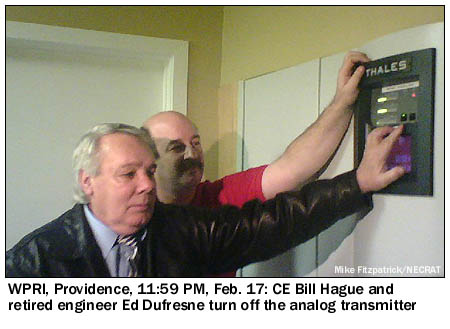
After years of publicity surrounding "February 17, 2009,"
the original target date for the sunset of analog TV in the U.S.
came and went without much change to the TV dial in most markets,
thanks to last-minute Congressional intervention that postponed
the analog shutdown to June 12, give or take a few weeks of "nightlight"
operation after the end of regular programming. Only a handful
of markets, most notably Providence, R.I. and Burlington, Vermont,
stuck with the original date, and the relatively smooth transition
process in those areas helped ease concerns in other markets
as the pace of on-air PSAs and behind-the-scenes engineering
work picked up in the spring.
A few more stations shut down analog ahead of the June deadline,
some deliberately and others out of necessity as aging transmitters
and antenna systems finally gave up the ghost. (Boston's Fox
outlet, WFXT, was perhaps the biggest station in that group,
fighting valiantly to keep a tiny analog signal on the air as
long as possible.)
When the big day finally dawned in June, it brought some surprises,
both good and bad. The FCC sent out field agents to make sure
at least one station in each remaining analog market stayed up
with "nightlight" service, a process that went smoothly
in most areas but hit a snag in Scranton, where WNEP (Channel
16) had to be brought back on line with a nightlight signal several
hours after it thought it had signed off for good. Call centers
were busy for a few days as viewers, predictably, waited until
the last minute (and then some) to hook up their new digital
tuners, but the flood of calls subsided quickly in most markets.
The big exception proved to be large-market stations that were
counting on a return to VHF to provide an optimum balance of
coverage and power costs. Several, including Philadelphia's WPVI
(Channel 6) and Boston's WHDH-TV (Channel 7), soon found that
much of their audience was simply unable to receive the VHF signal,
sending them scrambling for solutions. In WHDH's case, that meant
a return to its "interim" UHF signal - but other stations
(including WPVI) weren't able to make that move, instead asking
the FCC for power increases, fill-in boosters and other makeshift
solutions.
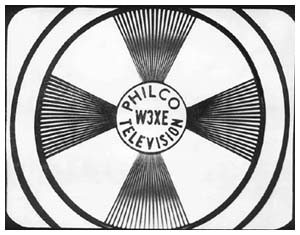 Meanwhile, TV's
history was being honored at some stations as they turned off
their analog signals - in Erie, for instance, WJET-TV's founder,
Myron Jones, was on hand to push the button that shut down analog
channel 24. (Our favorite sign-off moment was in Philadelphia,
where KYW-TV reached all the way back to its earliest history,
pulling out a test pattern from Philco experimental station W3XE
as its last analog image.) Meanwhile, TV's
history was being honored at some stations as they turned off
their analog signals - in Erie, for instance, WJET-TV's founder,
Myron Jones, was on hand to push the button that shut down analog
channel 24. (Our favorite sign-off moment was in Philadelphia,
where KYW-TV reached all the way back to its earliest history,
pulling out a test pattern from Philco experimental station W3XE
as its last analog image.)
Even after the call centers had closed down and the last of
those pesky red $40 converter-box coupons had expired, the fight
over DTV was far from finished, thanks to wireless carriers'
relentless demand for new spectrum. A new administration at the
FCC ended the year asking TV broadcasters to justify their use
of a big swath of desirable UHF bandwidth for a service that's
now used by a relatively small percentage of the TV audience,
setting the stage for a fight that's sure to extend into 2010
and beyond.
Meanwhile in Canada, analog TV remained the dominant over-the-air
medium (for the tiny minority of viewers not hooked up to cable
or satellite) as the CRTC looked to a 2011 digital transition
date that may bring an end to any over-the-air TV outside the
country's largest markets.
3. FM translators
While it was a rough year for the big guys, 2009 brought land-rush
business for anyone lucky (or foresighted) enough to be sitting
on a license for a low-power FM translator signal, thanks to
a relaxation of FCC rules that allowed translators to function
more like stand-alone commercial stations.
The door began opening in 2008, when the FCC quietly began
allowing translators to relay subchannels of parent FM HD signals,
and it burst wide open in 2009 when the Commission signed off
on a rule change that allowed translators to relay AM signals
without requiring Special Temporary Authority to do so.
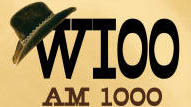 With AM-on-FM translator
authority limited to existing translators, that had the immediate
effect of boosting prices for translators, and by year's end
it was commonplace to see a translator that once might have fetched
$5,000 sell for as much as $75,000. The translator boom was most
dramatic in the kind of small markets that could easily be covered
by a 250-watt translator like the ones that brought 24-hour operation
to WIOO in Carlisle, PA or WCFR in Springfield, VT, but big markets
weren't immune: at year's end, a new AM-on-FM translator was
en route to the heart of the Rochester market for WYSL (1040
Avon), and another new translator had been granted in downtown
Brooklyn, beaming into lower Manhattan on 107.1. With AM-on-FM translator
authority limited to existing translators, that had the immediate
effect of boosting prices for translators, and by year's end
it was commonplace to see a translator that once might have fetched
$5,000 sell for as much as $75,000. The translator boom was most
dramatic in the kind of small markets that could easily be covered
by a 250-watt translator like the ones that brought 24-hour operation
to WIOO in Carlisle, PA or WCFR in Springfield, VT, but big markets
weren't immune: at year's end, a new AM-on-FM translator was
en route to the heart of the Rochester market for WYSL (1040
Avon), and another new translator had been granted in downtown
Brooklyn, beaming into lower Manhattan on 107.1.
Even if there wasn't a translator available in the same town
as an AM station that wanted one, there was still a solution,
at least with a little ingenuity: an existing translator could
be "hopped" from location to location until it reached
its destination. No signal moved more in 2009 than the translator
that started the year as W243CD on 96.5 in Gloucester. Fourteen
hops and four frequencies later, it landed 75 miles away in Fitchburg
on 105.3 as a relay for WPKZ (1280).
While small-town AM operators hailed the advent of FM translators
as a huge boon to their businesses, bigger operators experimented
with those HD-subchannel-on-FM translators. Saga was at the forefront,
adding new signals to its existing clusters in Ithaca, Keene
and Manchester/Concord, but a few smaller broadcasters were also
in the game, including Jeff Andrulonis' new "News-Talk 95.3"
in Smethport, PA.
If there was a downside to the translator boom, it was on
the low-power FM front, where proponents of community broadcasting
watched uneasily as more new translators kept filling up frequencies
that could have gone to LPFM. Even for them, the year had a happy
ending with House passage of a bill eliminating third-adjacent
protection for LPFMs, potentially opening the way for hundreds
of new LPFM signals in urban areas where no LPFM signal could
fit under current spacing rules.
4. Classical goes noncommercial
It could have been a much worse year for fans of classical
music in several big markets. The New York Times Company, beset
by its own financial woes, turned to its last broadcast property,
commercial classical outlet WQXR (96.3 New York), to help save
its bottom line - and in Boston, Nassau's collapse threatened
the future of commercial classical WCRB (99.5 Lowell), already
a much-diminished shell of itself.
Both stories had a reasonably happy ending thanks to public
broadcasters, though the scenarios played out rather differently
in each market.
 In New York, the
Times cashed out on 65 years of ownership of WQXR's big 96.3
signal in a complex trade with Univision Radio. For $33.5 million,
Univision took over that valuable class B spot on the New York
FM dial, trading its lesser-signalled WCAA (105.9 Newark NJ)
to the Times - which unloaded that class B1 signal and WQXR's
intellectual property to public broadcaster WNYC for an additional
$11.5 million. In New York, the
Times cashed out on 65 years of ownership of WQXR's big 96.3
signal in a complex trade with Univision Radio. For $33.5 million,
Univision took over that valuable class B spot on the New York
FM dial, trading its lesser-signalled WCAA (105.9 Newark NJ)
to the Times - which unloaded that class B1 signal and WQXR's
intellectual property to public broadcaster WNYC for an additional
$11.5 million.
The transfer took place on the night of October 8, though
another week would pass before Univision fully launched its new
96.3 property (as WXNY, "96X") - and for listeners
in or near New York City, the new WQXR on 105.9 tried to maintain
something close to status quo, retaining many of the announcers
from 96.3 even as it moved to WNYC's studios and transitioned
to listener-supported noncommercial status. For listeners more
distant from the Empire State Building, the news was not as good,
and at year's end WNYC continued to seek new ways to get its
classical signal to Long Island, Westchester and other areas
out of range of the new 105.9.
 In Boston,
there were no signal changes, but the December 1 transfer of
WCRB to public broadcaster WGBH still came with some static.
While WNYC had reduced its own classical programming to just
a few evening hours back in 2001, WGBH (89.7) had long staked
much of its own identity on its daytime classical broadcasts,
so the news that its $14 million purchase of WCRB would consolidate
all classical music on "All Classical 99.5," leaving
89.7 with news, talk and evening jazz, was unwelcome to the ears
of many classical fans throughout the huge coverage area of the
100 kW WGBH signal, especially in areas south of Boston where
the 99.5 signal was hard to receive. In Boston,
there were no signal changes, but the December 1 transfer of
WCRB to public broadcaster WGBH still came with some static.
While WNYC had reduced its own classical programming to just
a few evening hours back in 2001, WGBH (89.7) had long staked
much of its own identity on its daytime classical broadcasts,
so the news that its $14 million purchase of WCRB would consolidate
all classical music on "All Classical 99.5," leaving
89.7 with news, talk and evening jazz, was unwelcome to the ears
of many classical fans throughout the huge coverage area of the
100 kW WGBH signal, especially in areas south of Boston where
the 99.5 signal was hard to receive.
Fans of blues and folk music weren't happy, either, when WGBH
announced that those long-running Saturday blocks were going
away - and at year's end there were still plenty of questions
about how well WGBH would do as a competing news-talk voice against
long-established WBUR-FM (90.9).
5. WBCN fades away
Perhaps the year's biggest format change on the commercial
dial came in Boston, where CBS Radio stirred things up with the
August format shuffle that launched a new all-sports station,
WBZ-FM "98.5 the Sports Hub," relocated hot AC "Mix"
WBMX from 98.5 to 104.1, and removed the WBCN calls and rock
format from the Boston dial after more than four decades of prominence.
 While the WBCN that
remained in 2009 was a pale shadow of its best years as a freeform
pioneer in the late sixties and seventies, the station went out
in a blaze of glory and nostalgia. For four days leading up to
the August 13 signoff, WBCN veterans came back to the station
to spin their favorite tunes and share their stories, and by
the time Pink Floyd's "Shine On (You Crazy Diamond)"
closed things out, there weren't many dry eyes in the FM audience. While the WBCN that
remained in 2009 was a pale shadow of its best years as a freeform
pioneer in the late sixties and seventies, the station went out
in a blaze of glory and nostalgia. For four days leading up to
the August 13 signoff, WBCN veterans came back to the station
to spin their favorite tunes and share their stories, and by
the time Pink Floyd's "Shine On (You Crazy Diamond)"
closed things out, there weren't many dry eyes in the FM audience.
A ghost of WBCN lived on at the HD2 spot on the new WBZ-FM
(98.5), making a valiant effort to keep at least a spark of the
old station alive, while on the main channel the new "Sports
Hub" put on a full-court press against Entercom's sports
behemoth WEEI. With the Patriots and Bruins against WEEI's Red
Sox and Celtics, and with a lineup of talent that included former
WBCN morning team Toucher and Rich and well-known voices Gary
Tanguay, Mike Felger and Tony Massarotti, the new 98.5 was easily
the most intense challenge WEEI had faced in 18 years as an all-sports
station.
 While rumors swirled
about a WEEI move to FM (never consummated, as Entercom protected
its revenue stream from its two existing Boston-market FM properties),
the incumbent sports talker fought back on the AM dial, adding
ESPN programming after the collapse of "ESPN 890" WAMG
and building up its online presence at WEEI.com, as well as expanding
its New England-wide network to a new signal on Cape Cod. While rumors swirled
about a WEEI move to FM (never consummated, as Entercom protected
its revenue stream from its two existing Boston-market FM properties),
the incumbent sports talker fought back on the AM dial, adding
ESPN programming after the collapse of "ESPN 890" WAMG
and building up its online presence at WEEI.com, as well as expanding
its New England-wide network to a new signal on Cape Cod.
At least if early ratings are any judge, the fight will continue
to be a fierce one: while WEEI continued to lead the Sports Hub,
both stations drew big audiences, especially the younger males
who are traditionally hard for radio to reach.
Another sports battle broke out in the fall in Philadelphia,
where Greater Media took on CBS Radio's established player, WIP
(610), with an FM sister to its lower-rated ESPN Radio affiliate,
WPEN (950). The new "Sports Fanatic" (WPEN-FM 97.5)
faced an uphill battle, especially with most of the city's big
sports play-by-play franchises locked up on WIP and its sister
stations.
6. NBC plays with Leno, flirts with Comcast
The year's most debated TV programming decision, bar none,
was NBC's high-stakes move of Jay Leno from his comfortable (and
top-rated) perch on the Tonight Show to a new five-nights-a-week
block at 10 PM, replacing the increasingly expensive dramas that
filled that time slot.
As risky as the move was for NBC itself, the network at least
had the guaranteed payoff of much lower production costs for
the Leno show. For NBC's beleaguered affiliates, there was no
such silver lining - and one of the biggest affiliates, Ed Ansin's
WHDH-TV (Channel 7) in Boston, threatened to throw a big wrench
in NBC's plans.
In early April, Ansin drew nationwide headlines with his announcement
that when Andover native Leno took to the prime-time airwaves
in September, he wouldn't be seen in his home market, where Ansin
intended instead to run a 95-minute local newscast from 10-11:35
PM, eliminating the risk of a weak late news lead-in and retaining
all that ad revenue locally.
Faced with the threat of other defections, NBC took a tough
stand against Ansin, filling the trades with strong talk about
cutting off Ansin's NBC affiliation entirely if he refused to
carry the new Leno show and prompting reams of speculation about
where the Peacock might land in Boston if Ansin did lose the
affiliation.
 NBC's aggressive
response to Ansin's threatened defection appeared to scare off
other affiliates from following suit, and in the end Ansin himself
came around as well, agreeing to clear Leno's show at its scheduled
time. NBC's aggressive
response to Ansin's threatened defection appeared to scare off
other affiliates from following suit, and in the end Ansin himself
came around as well, agreeing to clear Leno's show at its scheduled
time.
In the end, Leno's ratings were even lower than expected,
reshaping the late local news ratings races in several competitive
markets around the region. (In Providence, for instance, Leno
was at least one factor in NBC affiliate WJAR's fall from its
usual perch at the top of the 11 PM ratings.)
And after all the to-do over Leno, NBC ended the year with
much bigger issues on its plate: the proposed takeover of the
entire network (and its parent, NBC Universal) by cable giant
Comcast, in an ongoing story that's sure to be one of the biggest
of 2010.
7. Pulse fizzles - but it's a Party instead
Has there ever been a major-market station so consistently
threatened with extinction as New York City's dance-music outlet,
"Pulse 87"?
 The innovative station,
actually a leased-time operation using the audio carrier of a
channel 6 low-power TV station, WNYZ-LP, entered 2009 having
lost its high-profile morning show, Star and Buc Wild, and soon
lost another signature personality, afternoon jock Jewelz Lopez. The innovative station,
actually a leased-time operation using the audio carrier of a
channel 6 low-power TV station, WNYZ-LP, entered 2009 having
lost its high-profile morning show, Star and Buc Wild, and soon
lost another signature personality, afternoon jock Jewelz Lopez.
But that was just the beginning of Pulse's woes, as the little
station fought to be included in New York's Arbitron ratings,
a battle it won, and struggled against the financial woes of
its parent company, Mega Media, which eventually filed for bankruptcy
in August, dooming plans to expand "Pulse" to other
channel 6 "Franken-FM" outlets in Washington, Chicago
and Los Angeles.
Along the way, WNYZ briefly tried to sustain itself on support
from its small but fiercely passionate listener base, launching
a pledge drive July 20 and then abruptly ending the campaign
the next day.
In the end, Mega was unable to make its lease payments to
WNYZ's owner, and Pulse signed off October 30 - but the 87.7
frequency soon came back to life with a similar format under
better-capitalized ownership, relaying JVC Broadcasting's "Party
FM" dance/hip-hop hybrid from WPTY (105.3 Calverton-Roanoke)
on Long Island's East End.
8. Leveille rides again
Amidst all the gloomy news that started the year, one of the
good guys won: WBZ (1030 Boston) overnight talk host Steve Leveille,
ousted from his spot in an ill-conceived cost-cutting attempt
to share a common overnight show among several CBS Radio talk
stations, returned to the air a month later on a groundswell
of listener and advertiser support.
 What happened? WBZ's
history explains part of it - previous attempts to add syndicated
talk content at night, including an ill-fated replacement of
the late David Brudnoy with Tom Snyder, had all fallen flat,
and Leveille's devoted fan base organized an outpouring of letters
and e-mails that helped to give the station's local management
the ammunition it needed to reverse what had been a corporate
decision in the first place. (It didn't hurt that Leveille's
advertisers came forward to put their money behind the local
host.) What happened? WBZ's
history explains part of it - previous attempts to add syndicated
talk content at night, including an ill-fated replacement of
the late David Brudnoy with Tom Snyder, had all fallen flat,
and Leveille's devoted fan base organized an outpouring of letters
and e-mails that helped to give the station's local management
the ammunition it needed to reverse what had been a corporate
decision in the first place. (It didn't hurt that Leveille's
advertisers came forward to put their money behind the local
host.)
While Leveille was back in place (and on Groundhog Day, ironically
enough), some of his colleagues were less fortunate. Lovell Dyett
remained stuck in a weekend-morning public affairs backwater,
and infomercials continued to invade the rest of the weekend
schedule. And the station lost another long-time voice when Gil
Santos, sports director since 1971, retired from his morning
shift at the end of January. (Another veteran WBZ sports voice,
Tom Cuddy, later returned to the station.)
9. TV news cutbacks
Local TV news was once a solid profit center for even the
smallest stations, but the sharp downturn in ad revenue and the
cost of the digital conversion put many struggling newsrooms
in jeopardy early in the year.
 Viewers in Syracuse
felt the pinch when they turned on the city's CBS affiliate,
Granite's WTVH (Channel 5) on March 2, to find the station's
noon newscast missing. The explanation came quickly on the city's
other stations: Granite had essentially shut down Syracuse's
oldest TV station after 60 years, handing WTVH over to erstwhile
competitor WSTM in a shared-services agreement that put more
than 40 people out of work and left Syracuse with just two broadcast
newsrooms. In June, Binghamton felt the pinch as well, when Newport's
WIVT (Channel 34) shut down most of what remained of its news
operation, leaving only a skeleton crew to augment a simulcast
of news from nearby Elmira and sister station WETM. Viewers in Syracuse
felt the pinch when they turned on the city's CBS affiliate,
Granite's WTVH (Channel 5) on March 2, to find the station's
noon newscast missing. The explanation came quickly on the city's
other stations: Granite had essentially shut down Syracuse's
oldest TV station after 60 years, handing WTVH over to erstwhile
competitor WSTM in a shared-services agreement that put more
than 40 people out of work and left Syracuse with just two broadcast
newsrooms. In June, Binghamton felt the pinch as well, when Newport's
WIVT (Channel 34) shut down most of what remained of its news
operation, leaving only a skeleton crew to augment a simulcast
of news from nearby Elmira and sister station WETM.
In two Pennsylvania markets - Erie and Scranton - once-competing
stations were already in shared-services agreements, but 2009
brought a new level of consolidation that came with more job
cuts, anyway. Lilly Broadcasting shuttered the studios of Erie's
WSEE-TV in late May, moving the station in with NBC affiliate
WICU-TV and reducing staffing; in Scranton, newscasts ended entirely
at CBS affiliate WYOU-TV. (Down the road in Hazleton, little
WYLN closed its news operation at year's end as well, putting
eight people out of work.)
The pain was even deeper in some small Canadian markets, where
stations in places such as London and Barrie became pawns in
a bigger battle between national broadcast groups like CTV and
Global and cable and satellite providers like Shaw and Rogers.
Claiming that national distribution of big-market signals was
cutting into viewership and revenue at small-market stations,
the broadcasters launched a public-relations campaign aimed at
drawing monthly carriage fees from cable and satellite. Along
the way, CTV threatened to shut down some of its smallest stations,
including CKNX-TV in Wingham, Ontario and CHWI-TV in Windsor.
Those signals survived as relays of London's CFPL-TV, but CTV
made deep cuts there and at other "A Network" outlets,
eliminating morning newscasts in London and Barrie and cutting
out the evening newscasts at CHRO in Ottawa.
In Hamilton, CanWest Global essentially walked away from CHCH
(Channel 11), selling the struggling station and its sister operation,
CJNT in Montreal, to cable programmer Channel Zero for $12 in
cash and assumption of debt. Without Global's programming, CHCH
ramped up its local news on a shoestring budget, filling in the
gaps with old movies as it tried to make a go of things as a
local independent.
(From the "could have been worse" files: several
other Canadian stations out west did shut down completely, and
CHEK in Victoria, B.C. came within hours of closure before a
local ownership group emerged to buy the station from CanWest.)
10. CSB dies, then returns
 The venerable Connecticut
School of Broadcasting trained a lot of the voices on the air
in New England, and even as jobs in the industry became ever
more elusive, CSB's campuses continued to churn out a steady
stream of hopeful new would-be broadcasters, filling internship
spaces and sometimes even finding paid work. The venerable Connecticut
School of Broadcasting trained a lot of the voices on the air
in New England, and even as jobs in the industry became ever
more elusive, CSB's campuses continued to churn out a steady
stream of hopeful new would-be broadcasters, filling internship
spaces and sometimes even finding paid work.
Until March 5, that is - when CSB's expansion-minded owners,
Credit Suisse, filed for bankruptcy and locked the doors on the
school's 26 campuses around the country, including the school's
original site in Farmington, Connecticut and six others around
the region.
As students worried about recovering deposits (some of them
as much as $12,000) and accessing the demo tapes they'd made
at CSB's studios, the school's founder returned to try to save
his creation. Dick Robinson bought back many of the school's
assets out of bankruptcy in May, restoring its original name
and reopening six of the northeastern locations and a handful
of others in the Carolinas, Georgia and Florida.

The Year in Station
Sales
It was a lousy year to be a seller, as station values cratered.
(Unless you happened to have a translator to sell, in which case
values were sharply up.) It was a lousy year to be a buyer, unless
you happened to have cash on hand, in which case it was actually
a pretty good year to be a buyer. And it was a lousy year to
be a station broker, period.
But even in the worst of economies, stations were bought and
sold, and as we do every year, NERW was there to chronicle them:
JANUARY: Just three station sales are filed all month
across the region, and all are in northern New England: On the
New Hampshire seacoast, Aruba Capital Holdings picks up WGIP
(1540 Exeter) from Clear Channel's Aloha spinoff trust for $325,000,
later flipping the station to oldies under new calls WXEX. In
Maine, national religious broadcaster EMF, one of the few buyers
in a frigid sales environment, files to buy WGUY (102.1 Dexter)
and WFZX (101.7 Searsport) from a Cumulus spinoff trust for $550,000.
FEBRUARY: The month's big deal comes in Connecticut,
where John Fuller's Red Wolf Broadcasting made its biggest purchase
yet, picking up WURH (104.1 Waterbury) from Clear Channel's Aloha
Radio Trust spinoff for $8 million.
The long soap opera at WKPQ (105.3 Hornell NY) appears to
come to an end with a $600,000 deal to sell the station to Phoenix
Radio Group, which bought the non-license assets of the station
in a foreclosure sale in 2007 and had been LMA'ing WKPQ and WHHO
(1320) from licensee Bilbat Radio LLC.
MARCH: James Johnson's Leatherstocking Media Group
bursts on the scene with a $950,000 deal to buy WMCR/WMCR-FM
(1600/106.3) in Oneida, NY from Vivian Warren. Nearby in Syracuse,
Craig Fox and Sam Furco ("Foxfur Communications") pay
Clear Channel's Aloha spinoff trust $1.25 million for WWDG (105.1
De Ruyter NY), the same signal Clear Channel bought from Fox
for $5 million back in 2000.
In New Hampshire, Andrew Sumereau's Birch Broadcasting strikes
a $1 million deal to buy WWHK (102.3 Concord) from Nassau, though
the sale was unconsummated at year's end.
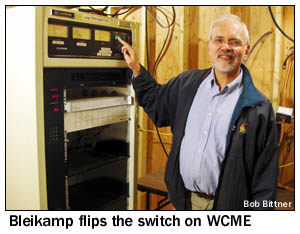 In Maine, Bob Bittner
sells WWBK (900 Brunswick) to Jim Bleikamp for $35,000. In Maine, Bob Bittner
sells WWBK (900 Brunswick) to Jim Bleikamp for $35,000.
Family Life Network adds to its network with the $65,000 purchase
of WCOP (106.1 Farmington Township PA) from World Radio Link.
APRIL: Ken Barlow and Lori Young-Barlow buy WVTK (92.1
Port Henry NY) from Barlow's Vox group for $550,000.
Jeff Andrulonis' Colonial Broadcasting steps in with a $275,000
deal to buy WFRM-FM (96.7 Coudersport PA) from Cary Simpson's
Farm and Home Broadcasting.
On TV, religious broadcaster Daystar buys dark WNGS (Springville/Buffalo
NY) and WNYI (Ithaca/Syracuse NY) and five other stations from
bankrupt Equity Media Holdings for $7.4 million.
In Canada, Shaw agrees to pay C$1 each to CTV for troubled
CKNX-TV in Wingham, Ontario, CHWI-TV in Wheatley/Windsor, Ontario
and CKX-TV in Brandon, Ontario, though the deal later falls through.
And in translator news, Central Broadcasting Company pays
Radio Assist Ministry $45,000 for translator W243CD (96.5 Gloucester),
setting that little translator on a 14-hop, 75-mile odyssey across
northern Massachusetts and southern New Hampshire en route to
a new identity, at year's end, as W288CK on 105.3, relaying Central's
WPKZ (1280 Fitchburg).
MAY: Lender Goldman Sachs takes control of Nassau Broadcasting,
forcing the spinoff of two stations in New Hampshire and one
in Maine to stay under ownership caps.
The Seneca Nation becomes a radio owner with the $250,000
purchase of a CP for 105.9 Little Valley NY from Randy Michaels'
RadioActive LLC.
 On the
Jersey shore, Rick Brancadora converts an LMA of WILW (94.3 Avalon)
to ownership, with a $1.475 million purchase from Coastal Broadcasting. On the
Jersey shore, Rick Brancadora converts an LMA of WILW (94.3 Avalon)
to ownership, with a $1.475 million purchase from Coastal Broadcasting.
Several sales of about-to-expire CPs: Wireless Fidelity of
North America gets Dan Priestly's CPs for 1230 Newport ME and
1240 Ellsworth ME, for $22,000 each; Silver Fish Broadcasting
gets WTTT (98.7 Stratford NH) from Jackman Holding Co. for $100,000;
WMJQ (1330 Ontario NY) from Bud Williamson to 21st Century Broadcasting,
for $60,000.
WOMA-LP (93.1 Lebanon PA) goes from defunct Radio Omega to
Calvary Chapel Lebanon for $18,000.
In Canada, My Broadcasting picks up CIYN (95.5 Kincardine
ON) for C$1,126,520, while Rogers buys the remaining 75% of CIKR
(105.7)/CKXC (93.5) in Kingston, Ontario from John Wright and
Doug Kirk for C$8.8 million.
JUNE: In Pittsburgh, Believe & Achieve Family Educational
Center converts its LMA of WZUM (1590 Carnegie PA) to an $800,000
purchase from Sovereign City Radio Services.
Calvary Chapel of Costa Mesa sells WWFP (90.5 Brigantine/Atlantic
City NJ) to Hope Christian Church of Marlton for $50,000.
Unbuilt WVVT (670 Essex Junction VT) sells for $1, from Alfred
Alonso and Charles Hecht to Hilda Gallant and Paul Salas, to
keep the about-to-expire CP alive through January 2011.
On the translator front, Mountaintop Enterprises sells W248AB
(97.5 Bolton CT), with Hartford-market coverage, to John Fuller's
Red Wolf Broadcasting for $100,000; Horizon Christian Fellowship
sells W244CF (96.7 Plymouth MA) to Kingdom Church Inc. (owner
of WMSX 1410 Brockton) for $70,000.

JULY: The big headline comes from New York City, where
the New York Times Company sells WQXR-FM (96.3) to Univision
Radio for $33.5 million plus Univision's WCAA (105.9 Newark NJ)
license, which then goes to public broadcaster WNYC, along with
the WQXR calls and format, for $11.5 million.
Family Life Ministries picks up WGMF-FM (107.7 Dallas/Scranton
PA) from GEOS Communications in a $1 million deal that trades
existing Family Life station WCIG (91.3 Carbondale) to Telikoja
Educational Broadcasting, controlled by GEOS principals Kevin
Fitzgerald and Ben Smith. WGMF-FM becomes WCIG, while 91.3 becomes
WFUZ.
In Harrisburg, One Heart Ministries converts its LMA of WKBO
(1230) into a purchase from Clear Channel, for $385,000.
South of Erie, WCTL (106.3 Union City) picks up WTMV (88.5
Youngsville) for no cash consideration.
Utica's WRUN (1150) goes to Digital Radio Broadcasting, which
gets the AM station and $20,000 from Albany's WAMC in exchange
for translator W247BM (97.3 Cooperstown).
In Canada, Evanov adds to its growing group with the acquisition
of CKPC (1380) and CKPC-FM (92.1) in Brantford, Ontario from
Telephone City Broadcast Ltd.; in Peterborough, Andy McNabb buys
silent CKKK (90.5) from King's Kids Promotions Outreach Ministries.
AUGUST: On Long Island, John Caracciolo and Vic Latino's
new JVC group reworks its deal to buy WBON (98.5 Westhampton)
and now WDRE (105.3 Calverton-Roanoke) from Jarad Broadcasting
for a total of $2.7 million - $1 million for WBON and $1.7 million
for WDRE.
 In the month's other
big deal, Buckley sells WSEN/WSEN-FM (1050/92.1 Baldwinsville
NY) and WFBL (1390 Syracuse) to James Johnson's Leatherstocking
for $2.1 million. In the month's other
big deal, Buckley sells WSEN/WSEN-FM (1050/92.1 Baldwinsville
NY) and WFBL (1390 Syracuse) to James Johnson's Leatherstocking
for $2.1 million.
EMF Broadcasting announces a purchase of WOGI (98.3 Duquesne/Pittsburgh
PA) from Keymarket, though no sale agreement is filed at the
FCC by year's end.
Calvary Chapel of Twin Falls sells WREQ (96.9 Ridgebury PA/Elmira
NY) to Europa Communications for $275,000. Over in the Scranton
market, Lex Sloot buys WAZL (1490 Hazleton PA) from WS2K.
Jimmy Swaggart's Family Worship Center Church buys new WYRR
(88.9 Lakewood/Jamestown NY) from Muncy Hills Broadcasting for
$10,000.
In Canada, Canwest Global sheds Hamilton's CHCH (Channel 11)
and Montreal's CJNT (Channel 62) to cable programmer Channel
Zero, for C$12 and assumption of liabilities.
SEPTEMBER: Boston's WGBH steals the month's headlines
with its $14 million purchase of Nassau's classical WCRB (99.5
Lowell), but there's other news from Nassau as well: Jeff Shapiro's
Great Eastern Radio adds two more New Hampshire signals, WNNH
(99.1 Henniker) and WWHQ (101.5 Meredith), in a $700,000 purchase.
On the translator front, Saga pays Clear Channel $45,000 for
W252AA (98.3 Ithaca), which moves to 98.7 as W254BF, "98.7
the Vine," with a AAA format from Saga's WYXL-97.3HD3.
 OCTOBER: Peconic Public
Broadcasting agrees to a $2.425 million deal (only $800,000 of
it in cash) for Long Island University's WLIU (88.3 Southampton
NY). OCTOBER: Peconic Public
Broadcasting agrees to a $2.425 million deal (only $800,000 of
it in cash) for Long Island University's WLIU (88.3 Southampton
NY).
Bold Gold Media Group expands in Scranton, with a $500,000
deal to buy WLNP (94.3 Nanticoke), WNAK (730 Nanticoke) and WCDL
(1440 Carbondale) from WS2K.
On the Jersey Shore, a $375,000 deal sends WEHA (88.7 Port
Republic) from Vin-Lor Broadcasting to Spreading the Gospel.
NOVEMBER: In Massachusetts' Merrimack Valley, Gois
Broadcasting enters an LMA (with eventual purchase) of J Sports'
WLLH (1400 Lowell and Lawrence MA).
Don Crawford, Jr.'s DJRA Broadcasting LLC pays dad Don Crawford,
Sr.'s Kimtron Inc. $350,000 for Rochester-market WLGZ (102.7
Webster NY).
Tri-State Public Communications pays Willpower Radio $235,000
for WHDD (1020 Sharon CT). Finger Lakes Radio Group files to
transfer WSFW (1110 Seneca Falls NY) to Calvary Chapel of Twin
Falls, in a trade for translator W214BR (90.7 Geneva).
DECEMBER: Bruce Collier and Joseph Green (Trustworthy
Radio) file to convert their LMA of WHYL (960 Carlisle PA) to
a purchase, for $300,000, in the month's only significant deal.

The Year in Programming,
People and Calls
JANUARY: Job cuts are the month's headline, over and
over again, starting with the (temporary) ouster of Steve Leveille
and Tom Cuddy at Boston's WBZ and the more permanent dismissal
of several of their colleagues there and at Hartford's WTIC.
Then comes the first of the big group-wide cuts: 1850 in all
at Clear Channel, including dozens of good radio people across
the northeast, some of them long-serving veterans like Rochester
newsman Bill Lowe. Citadel cuts in Providence, Springfield and
Buffalo, too, dismissing good people like WHTT's Jim Pastrick,
and there are cuts at Rochester's Stephens Media cluster as well.
Chris Booker returns - yet again - to New York's "K-Rock,"
though not for long, and down on the Jersey shore, Press dumps
"G-Rock Radio" in favor of top-40 "Hits 106"
at WHTG-FM (106.3 Eatontown NJ) and WBBO (106.5 Bass River Township
NJ).
In Maine, WLVP (870 Gorham) and WLAM (1470 Lewiston) flip
from ESPN Radio to oldies. Blueberry's WKCG (101.3 Augusta) drops
"Star" AC (shifted over to WCME 96.7 Boothbay Harbor)
and soon trades its old calls for WVQM, reflecting its new simulcast
with Bangor-market news-talker WVOM (103.9 Howland).
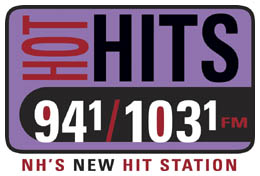 Saga launches more
new HD2-on-translator "stations" in New Hampshire:
in Keene, it's oldies "Cool 103.1" on WKNE-FM-103.7HD3
and W276CB (103.1) and classic rock on WKNE-FM's HD2 and W281AU
(104.1), later moving to a new translator on 99.1 - and a week
later, it puts "Hot Hits 94.1/103.1" on Manchester's
WZID-95.7HD2 and on W231BR (94.1 Manchester) and W276BJ (103.1
Concord). Saga launches more
new HD2-on-translator "stations" in New Hampshire:
in Keene, it's oldies "Cool 103.1" on WKNE-FM-103.7HD3
and W276CB (103.1) and classic rock on WKNE-FM's HD2 and W281AU
(104.1), later moving to a new translator on 99.1 - and a week
later, it puts "Hot Hits 94.1/103.1" on Manchester's
WZID-95.7HD2 and on W231BR (94.1 Manchester) and W276BJ (103.1
Concord).
In New York's Southern Tier, late-2008 format changes caught
by NERW in early 2009 include WABH (1380 Bath) from oldies to
ESPN and WHHO (1320 Hornell) from oldies to Fox Sports. Fox Sports
also replaces oldies on WJST (1280 New Castle PA). In Smethport
PA, WXMT (106.3) flips to classic rock as "The Mountain,"
and in Laporte PA, WCOZ (103.9) becomes WNKZ, flipping from "Gem
FM" oldies to "KZ104" hot AC.
Astral's "Virgin Radio" brand comes to Ottawa, on
the rocker formerly known as "The Bear" (CKQB 106.9)
and to Montreal, on the AC station formerly known as "Mix
96" (CJFM 95.9).
New calls: WPMW (88.5 Bayview MA), WYRR (88.9 Lakewood NY),
WVWA (90.3 Auburn NY), WRPB (89.3 Benedicta ME), WHPF (88.1 Pittston
Farm ME), WMHU (91.1 Cold Spring NY), WFWO (89.7 Medina NY),
WCOZ (90.5 Laceyville PA).
New to the air: WXLQ (90.5 Bristol VT), part of the North
Country Public Radio network; WYPM (93.3 Chambersburg PA), the
relocated WROG 102.9 Cumberland MD, with public radio from WITF
in Harrisburg at 10 AM on Jan. 9; WUMM (91.7 Machias ME), in
late December 2008; CKKW-FM (99.5 Kitchener ON), at 3 PM Jan.
6.
Gone for good: CKKW (1090 Kitchener ON), on Jan. 16.

FEBRUARY: Amidst the ongoing sea of layoffs, with Cumulus
cutting across most of its markets, comes some interesting engineering
news: the long, complex move of three AM stations to the site
in Newton once occupied solely by WUNR (1600) begins to wrap
up, as WRCA (1330) and WKOX (1200) receive their licenses to
broadcast from the site.
WKOX's usual simulcast partner, WXKS (1430), breaks away for
a few weeks to carry a nonstop loop of the new album from Ernie
and the Automatics, the (pretty good, actually) band led by car
dealer Ernie Boch, Jr.
Veteran New York programmer Tom Cuddy departs New York's WPLJ,
though it will be the end of the year before we start hearing
the back story of the turmoil inside Citadel that drives him
out after 19 years. Across the market, CBS Radio begins to move
the first of its staffers into new cluster studios downtown on
Hudson Street, a process that will continue through the fall
as four studio locations are combined into one.
 A new signal debuts
in the Watertown, N.Y. market February 9, as Community Broadcasters'
WEFX (94.1 Calcium) signs on with a simulcast of "Real Rock"
WOTT (100.7 Henderson), then swaps calls with the older station
two days later, putting "Real Rock" on the new 94.1
and launching classic hits "The Fox" on WEFX 100.7. A new signal debuts
in the Watertown, N.Y. market February 9, as Community Broadcasters'
WEFX (94.1 Calcium) signs on with a simulcast of "Real Rock"
WOTT (100.7 Henderson), then swaps calls with the older station
two days later, putting "Real Rock" on the new 94.1
and launching classic hits "The Fox" on WEFX 100.7.
In Maine, Bangor's WABI (910) drops its venerable calls for
WAEI, matching sister FM WAEI-FM (97.1). Speaking of sports,
ESPN Radio comes to Rhode Island and southeastern Massachusetts
with the flip of Hall's WLKW (1450 West Warwick RI) and WNBH
(1340 New Bedford MA) from standards.
Lawrence's WNNW (800) gains an FM translator, W221CH (92.1),
moved down from New Hampshire.
Call changes: WJSM (1110 Martinsburg PA) to WWBJ, KCBE (sic)
90.7 Napeague NY to WEGB.
New calls: WWLN (90.5 Lincoln ME), WJVH (91.5 Belfast ME),
WTWT (90.5 Bradford PA), WLNJ (91.7 Lakehurst NJ), WVWA (90.3
Auburn NY), WINO (89.9 Odessa NY).
New to the air: WDNJ (88.1 Hopatcong NJ), with Spanish-language
religion.
Back on the air: CKRZ (100.3 Ohsweken ON), Feb. 12 after a
two-week shutdown that threatened to take the station dark for
good.
 MARCH: One
of the biggest format changes of the year - and certainly the
biggest so far - is the March 11 flip of CBS Radio's New York
"K-Rock" (WXRK 92.3) to top-40 "92.3 Now FM,"
touching off a format battle with Clear Channel's "Z100"
(WHTZ 100.3) that closely parallels another CBS/CC top-40 fight
on the opposite coast, where CBS newcomer "97.1 AMP FM"
(KAMP-FM, formerly FM talker KLSX) takes on venerable KIIS-FM
(102.7) in Los Angeles. Newcomers Tik Tak (from Detroit) and
Lisa Paige (from Philadelphia) fill afternoons and middays, but
it will be nearly the end of the year before a morning show (radio
newcomer Nick Cannon) is be announced. Across town at Emmis,
Jeff Foxx is out after a few years in morning drive - and all
over town, radio people are stunned by the brutal murder of WABC
newsman George Weber and the subsequent arrest of a 16-year-old
suspect in the killing. MARCH: One
of the biggest format changes of the year - and certainly the
biggest so far - is the March 11 flip of CBS Radio's New York
"K-Rock" (WXRK 92.3) to top-40 "92.3 Now FM,"
touching off a format battle with Clear Channel's "Z100"
(WHTZ 100.3) that closely parallels another CBS/CC top-40 fight
on the opposite coast, where CBS newcomer "97.1 AMP FM"
(KAMP-FM, formerly FM talker KLSX) takes on venerable KIIS-FM
(102.7) in Los Angeles. Newcomers Tik Tak (from Detroit) and
Lisa Paige (from Philadelphia) fill afternoons and middays, but
it will be nearly the end of the year before a morning show (radio
newcomer Nick Cannon) is be announced. Across town at Emmis,
Jeff Foxx is out after a few years in morning drive - and all
over town, radio people are stunned by the brutal murder of WABC
newsman George Weber and the subsequent arrest of a 16-year-old
suspect in the killing.
The month's other big format news comes from Canada, where
March 26 brings the end of oldies on CHUM (1050 Toronto), replaced
with a nearly-unlistenable (and nearly un-listened-to) simulcast
of CTV's CP24 TV news channel.
On Cape Cod, the WEEI sports network expands to the former
WRZE (96.3 Dennis), which flips from top-40 "Rose"
to new identity WEII on March 25.
 In Maine, Saga moves
"hot talk" from WZAN (970 Portland) to WBAE (1490 Portland)/WVAE
(1400 Biddeford), displacing "The Bay" standards from
that simulcast and sending 970 over to a conservative talk format.
Up north, Stephen King begins simulcasting sports WZON (620)
on WDME (103.1 Dover-Foxcroft) and Blueberry flips WCME (96.7
Boothbay Harbor) from "Star" AC (the former WKCG 101.3
Augusta format) to a simulcast of rocker WTOS (105.1 Skowhegan). In Maine, Saga moves
"hot talk" from WZAN (970 Portland) to WBAE (1490 Portland)/WVAE
(1400 Biddeford), displacing "The Bay" standards from
that simulcast and sending 970 over to a conservative talk format.
Up north, Stephen King begins simulcasting sports WZON (620)
on WDME (103.1 Dover-Foxcroft) and Blueberry flips WCME (96.7
Boothbay Harbor) from "Star" AC (the former WKCG 101.3
Augusta format) to a simulcast of rocker WTOS (105.1 Skowhegan).
On the Jersey shore, WTAA (1490 Pleasantville/Atlantic City)
flips from satellite-fed "La Gran D" Spanish AC to
"La Fiesta" from Long Island's WBON.
At month's end, the end of Nassau's LMA (and unconsummated
purchase) of WFKB (107.5 Boyertown) flips the station from classic
hits "Frank FM" back to contemporary Christian "Alive
FM," WBYN-FM.
Down the road in Philadelphia, Jerry Lee takes a stand against
high fees by cutting off streaming at his WBEB (101.1), which
remains a dominant station in the market nonetheless.
In Quebec, Corus drops French-language news and talk from
its network of signals in Sherbrooke, Trois-Rivieres, Saguenay
and Gatineau-Ottawa, in favor of "Souvenirs Garantis"
French classic hits/oldies.
Call changes: WCRR (107.3 South Bristol Township NY) to WROO;
WJJZ (90.1 North Salem NY) to WJZZ; WFYN (101.5 Waynesboro PA)
to WBHB-FM; WANB-FM (103.1 Waynesburg) to WKVE-FM.
New calls: WSVP (88.7 Connellsville PA), WCOP (106.1 Farmington
Township PA), WGXC (90.7 Acra NY), WNGB (91.3 Petersham MA),
WNGF (89.9 Swanton VT).
New to the air: WGMY (88.1 Montgomery NY), with religion;
CHSB (99.3 Bedford NS), also with religion; CFEP (105.9 Eastern
Passage NS), on March 13, with a much better metro Halifax signal
for "Seaside FM" than its old low-power 94.7 signal.
Gone for good: Aboriginal Voices Broadcasting's CKAV-FM-10
(106.7 Montreal) and never-built CKAV-FM-8 (102.5 Kitchener ON).
APRIL: While the TV industry wraps itself up in questions
about Jay Leno and WHDH, a familiar story once again surfaces
from New York City's noncommercial airwaves: yet another in the
seemingly annual series of leadership struggles at Pacifica's
WBAI, this time complete with a change of locks at the station's
Empire State Building transmitter site.
 A venerable callsign
disappears from western Massachusetts April 6, as WMAS (1450
Springfield) becomes WHLL, "The Hall," dropping True
Oldies Channel oldies for ESPN sports from its new studio home
in the Basketball Hall of Fame. A venerable callsign
disappears from western Massachusetts April 6, as WMAS (1450
Springfield) becomes WHLL, "The Hall," dropping True
Oldies Channel oldies for ESPN sports from its new studio home
in the Basketball Hall of Fame.
"True Oldies" also vanishes from Providence a week
later, when Citadel's WPRV (790) flips to a mix of talk and business.
In southern Maine, WGEI (95.5 Topsham) flips from WEEI-network
sports to talk as WLOB-FM, returning that format to the FM dial
a year after it retreated to AM. Talk comes to the FM dial on
the New Hampshire seacoast as well April 1, when Clear Channel
flips WQSO (96.7 Rochester) from oldies to a mostly-simulcast
of sister station WGIN (930 Rochester).
A strange tabloid saga surrounds former WNTK (99.7 New London
NH) morning man Aaron Aldridge, who vanishes with his teenage
daughter. She eventually turns up in Florida, but he's not caught
for a few more days, while news emerges that he's wanted on child
porn charges. Coincidentally, he turns up in California, not
far from the NAB Show underway in Las Vegas - and WNTK hires
a different morning man.
In the Hudson Valley, WGHQ (920 Kingston NY), WBNR (1260 Beacon
NY) and WLNA (1420 Peekskill NY) all flip from standards to talk
as the "Hudson Valley Talk Radio Network." In Binghamton,
radio shines and short-staffed TV newsrooms struggle to cover
a mass shooting that makes national headlines. And in New York
City, Len Berman is out after many years at WNBC (Channel 4)
as that station reconfigures its news offerings.
On the Jersey shore, WILW (94.3 Avalon NJ) flips to "Wibbage-FM,"
still with oldies.
 Altoona's WBXQ (94.3)
flips from classic rock to "True Country 94.3". Altoona's WBXQ (94.3)
flips from classic rock to "True Country 94.3".
And at month's end, Clear Channel cuts another 600 or so staffers
around the country, including a number of programmers, news people
and jocks across the NERW region - while at Citadel's WABC, the
(apparently final) "Rewound" nostalgia-fest is relegated
to a podcast with the departure of PD Phil Boyce.
Call changes: WEIM (1280 Fitchburg MA) to WPKZ, "The
Heart of New England's Pulse"; WELX (107.1 Dannemora NY)
to WNMR, as the station ends its WCLX (102.9 Westport NY) simulcast
and goes silent for most of the rest of the year; WDBA (107.3
Du Bois PA) to WCOH.
New calls: WCIJ (90.9 Laporte PA), WMWR (89.5 Lincoln ME).
New to the air: WZDB (95.9 Sykesville/Du Bois PA), with classic
rock.
Back from the dead: WARM (590 Scranton PA), on April 23, after
an absence of several weeks.
MAY: Boston talker Jay Severin spends most of the month
in the headlines after making controversial comments about Mexicans
and the swine flu; he'll serve a three-week suspension before
returning to the air June 2. Over at WBZ, Tom Cuddy returns to
afternoon-drive sports, relieving the news anchors of that duty.
 In Pittsburgh, fans
of urban WAMO-FM (106.7) and its AM sister stations protest after
owner Sheridan announces it's pulling the plug and selling the
signals to a Catholic broadcaster; later in the year, veteran
'Burgh broadcaster Eddie Edwards will attempt to bring back urban
radio on an AM signal, but his planned purchase of WPYT (660)
is derailed, he says, by health problems. In Pittsburgh, fans
of urban WAMO-FM (106.7) and its AM sister stations protest after
owner Sheridan announces it's pulling the plug and selling the
signals to a Catholic broadcaster; later in the year, veteran
'Burgh broadcaster Eddie Edwards will attempt to bring back urban
radio on an AM signal, but his planned purchase of WPYT (660)
is derailed, he says, by health problems.
On the HD Radio dial, Clear Channel's WXDX (105.9) announces
a subchannel dedicated, 24/7, to the Penguins; it will launch
in the fall when hockey season begins.
Across the state in Philadelphia, public broadcaster WHYY
cuts jobs and announces the impending end of its Wilmington,
Delaware studio facility and nightly newscast, a move Delaware
officials try to thwart with a license challenge at year's end.
Hartford-market WURH (104.1 Waterbury) returns to its old
"Radio 104" modern rock format and WMRQ calls under
new owner John Fuller, while in Providence, WSNE (93.3) listeners
get Boston-based "Matty in the Morning" (also now heard
in New Hampshire) in place of their local morning show.
In Syracuse, Craig Fox and Sam Furco flip new purchase WWDG
(105.1 DeRuyter) from hot AC "Nova" (silent on May
1) back to its old "Love FM" religious format under
its old calls WVOA-FM; the former WVOA-FM (103.9 Mexico NY) becomes
WVOU, though it will later return to the WVOA-FM calls when 105.1
flips again. Over in Utica, a well-publicized "format change"
stunt brings morning man Eric Thomas from Michigan to Roser's
"Kiss FM" simulcast (WSKS/WSKU); Thomas lasts only
a few weeks on the job and later disclaims all responsibility
for the stunt.
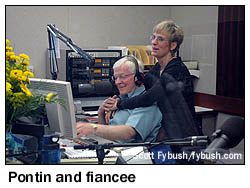 In the Hudson Valley,
Clear Channel's "Lite 98.5" WCTW Catskill returns to
hot AC as "The Cat." And in Rochester, veteran WXXI-FM
morning man Simon Pontin learns to sleep late, retiring after
33 years of wakeup duty. In the Hudson Valley,
Clear Channel's "Lite 98.5" WCTW Catskill returns to
hot AC as "The Cat." And in Rochester, veteran WXXI-FM
morning man Simon Pontin learns to sleep late, retiring after
33 years of wakeup duty.
In eastern Massachusetts, WWZN (1510 Boston) adds more progressive
talk, under a leased-time deal with Jeff Santos' Revolution Radio,
while WNEB (1230 Worcester) returns to the air with Spanish talk
as "Radio Sol."
On TV, WMFP (Channel 62) in the Boston market adds Retro TV
programming.
New calls: WZME (1120 Richmond ME), WNGG (90.9 Gloversville
NY), WGSS (89.3 Copiague NY), WPHH (91.1 Conway NH), WLEK (101.1
Machias ME).
Call changes: WXHD (90.1 Mount Hope NY) to WMFU, matching
simulcast parent WFMU 91.1 East Orange NJ; WFZX (101.7 Searsport
ME) to WKVV, WGUY (102.1 Dexter ME) to WKVZ; unbuilt WRMR (89.7
Lindenhurst NY) to WOBH; WWBK (900 Brunswick ME) to WCME; WCME
(96.7 Boothbay Harbor ME) to WTQX.
Back from the dead: WCKL (560 Catskill NY), making a longer-than-usual
return to keep its license alive.
New to the air: WIGV-LP (96.5 Providence), on May 18.
Gone for good: CHLT (630 Sherbrooke QC) and CJRC (1150 Gatineau
QC/Ottawa ON), on May 1.

JUNE: It's all about TV for most of the month, as analog
signals fade away, digital signals boost power to compensate,
and your editor runs himself ragged trying to document all the
history.
In a curious bit of news that's not directly related to the
transition, troubled WLNE (Channel 6) in the Providence market
loses its top syndicated shows, including Dr. Phil and Inside
Edition, when it's unable to pay syndicator King World. Meanwhile
on cable, Comcast buys out Hearst's half of New England Cable
News, sending founder/GM/president Charlie Kravetz packing.
 But there's news
on radio as well: "Kiss FM" returns to Toronto June
5, as Rogers pulls the plug on "Jack FM" CJAQ (92.5),
taking it back to top-40 with new calls CKIS. In New York, Billy
the Kidd leaves the night shift at Z100, while Matt Pinfield
takes a temporary leave from the WRXP morning show to enter rehab. But there's news
on radio as well: "Kiss FM" returns to Toronto June
5, as Rogers pulls the plug on "Jack FM" CJAQ (92.5),
taking it back to top-40 with new calls CKIS. In New York, Billy
the Kidd leaves the night shift at Z100, while Matt Pinfield
takes a temporary leave from the WRXP morning show to enter rehab.
ESPN Radio moves to FM in south Jersey, as WXKW (97.3 Millville)
drops its "New Jersey 101.5" simulcast and becomes
WENJ-FM; WENJ (1450 Atlantic City) segues from English ESPN to
Spanish ESPN Deportes.
An odd story from upstate New York finds neighbors complaining
about interference and health problems from the relocated transmitter
of WOKR (93.5 Remsen); after several months of testing, the FCC
finds nothing out of the ordinary and the neighbors eventually
move home. Meanwhile in Rochester, the last of Clear Channel's
stations leaves now-vacant Midtown Plaza for new digs across
the street.
An even odder story from New Jersey finds PMCM, a company
co-owned with Press Communications, applying to move two small
VHF stations from Nevada and Wyoming to New Jersey and Delaware
- or rather, to New York City and Philadelphia. At year's end,
the FCC will deny the moves, but an appeal is pending.
Budget woes hit Erie's WQLN, which cuts the jobs of five staffers,
including its program director and chief engineer, and cuts the
pay of those remaining.
Canadian linguistic politics lead the government to overturn
the award of two new radio licenses in Ottawa to Astral and Frank
Torres; after tests identify a third available frequency that
can be used for a French-language frequency, both licenses (and
a third in French) are re-granted later in the year.
And at month's end, the death of Michael Jackson reminds radio
of a time when it still brought everyone together musically.
Call changes: WGMY (88.1 Montgomery NY) to WNYX, WBUD (1310
Asbury Park NJ) back to WADB, WJZI (107.1 Livingston Manor NY)
to WBZX, moving to Hancock NY; WEMR (1460 Tunkhannock PA) to
WGMF.
New calls: WRGY (90.5 Rangeley ME), WPVH (90.7 Plymouth NH),
WPFG (91.3 Carlisle PA), WOPG (89.9 Esperance NY), WTMI (88.7
Fleming NY), WGUY (1230 Newport ME), WEMR (88.7 Dushore PA),
CIYM (100.9 Brighton ON), CKWD (99.1 Wallaceburg ON), CJHK (100.7
Bridgewater NS).
New to the air: CKRU-FM (100.5 Peterborough ON), June 15;
WHHN (88.1 Hollidaysburg/Altoona PA).
JULY: It's a bad month for two public TV stations near
the Canadian border, as Canadian cable giant Rogers threatens
to drop Erie's WQLN from systems in London, Ontario and Watertown's
WPBS from its systems in Ottawa. With much of their membership
base about to be cut off, both stations sign deals to transmit
their signals across the border by fiber to alleviate Rogers'
concerns about picture quality.
In commercial TV news, Multicultural's New York-market WSAH
(Channel 43) picks up Retro TV programming, but soon drops it,
citing programming and cost issues. Young Broadcasting goes up
for sale, without finding a buyer, though Gray Broadcasting signs
on to manage many of the bankrupt company's stations, including
WTEN (Channel 10) in Albany. In West Hartford, NBC's WVIT (Channel
30) moves next door to a state-of-the-art new building, leaving
behind its 1953-vintage building.
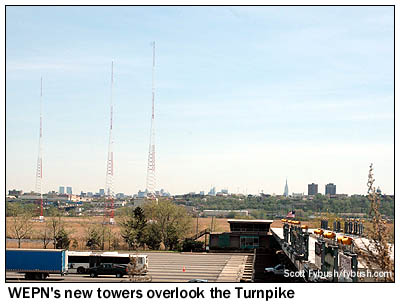 ESPN Radio's WEPN
(1050 New York) flips the switch on its new transmitter site
near the mouth of the Lincoln Tunnel, ending a long struggle
to move away from a huge construction project that disrupted
the station's old site nearby. ESPN Radio's WEPN
(1050 New York) flips the switch on its new transmitter site
near the mouth of the Lincoln Tunnel, ending a long struggle
to move away from a huge construction project that disrupted
the station's old site nearby.
WGSM (107.1 Greensburg PA) ditches adult hits "Sam FM"
for classic hits as "G-107."
In eastern Canada, CFQM (103.9 Moncton NB) flips from AC "Magic
104" to classic hits "Max FM 103.9" at month's
end.
Call changes: WFRM-FM (96.7 Coudersport PA) to WLMY, moving
to Portville/Olean NY.
New calls: WHVM (91.9 Owego NY, replacing WLJM); WDMY, then
WHNM (91.9 Stockbridge MA); WWRN (91.5 Rockport MA), WFYB (91.5
Fryeburg ME), WRNM (91.7 Ellsworth ME).
New to the air: CKXM (90.5 Exeter ON), testing, with official
launch Aug. 31; WBZX (107.1 Hancock NY), relaying Scranton's
"Rock 107" WEZX.
Gone for good: CFDR (780 Dartmouth NS), at 10 AM July 27,
replaced by CKLT 92.9.
AUGUST: While plenty of attention is focused on 104.1
in Boston, where WBCN is breathing its last, Citadel's "Mix
104.1" (WHTT-FM Buffalo) very quietly returns from AC to
classic hits.
 In Syracuse, Craig
Fox and Sam Furco flip their new acquisition WVOA-FM (105.1 DeRuyter)
to country as WOLF-FM, challenging Clear Channel's established
"B104.7" (WBBS Fulton). In Syracuse, Craig
Fox and Sam Furco flip their new acquisition WVOA-FM (105.1 DeRuyter)
to country as WOLF-FM, challenging Clear Channel's established
"B104.7" (WBBS Fulton).
Clear Channel responds to its new "Wolf Country"
competition by flipping urban "Power 106.9" WPHR (newly
moved from Auburn to Solvay) to "Young Country" for
just a weekend, then returns the station to urban.
News-talk comes to FM in State College Aug. 3 with the flip
of "Qwik Rock" WQWK (103.1) to talk WRSC-FM; WRSC (1390)
goes to progressive talk and sports WMAJ (1450) picks up the
WQWK calls.
Up in Bradford, PA and nearby Olean, NY, WLMI (103.9 Kane
PA) flips to country "Bob FM," as does WBYB (96.7 Portville
NY).
North of Boston, Keating Willcox's WNSH (1570 Beverly) drops
talk for a simulcast of Spanish religion WESX (1230 Nahant),
but that simulcast will end at year's end, replaced once again
by talk on 1570.
In Toronto, CHUM-FM (104.5) quietly vacates 1331 Yonge Street
after half a century at that famed address, moving to a new studio
at 250 Richmond Street West.
Call changes: WILW (94.3 Avalon NJ) to WIBG-FM, WDME (103.1
Dover-Foxcroft ME) to WZON-FM, now simulcasting sports WZON (620
Bangor). WLMY (96.7 Portville NY) to WBYB; WRVH (107.9 Williamsport
PA) to WLMY. WGXM (88.7 Port Republic NJ) to WEHA.
New calls: WJNF (91.7 Dalton MA), WFGP (91.1 Greene ME), WTBP
(89.7 Bath ME), WWTP (88.5 Augusta ME), WVVC (88.5 Dolgeville
NY).
Back on the air: WDCR (1340 Hanover NH), temporarily, to keep
its license alive.
New to the air: CIGM-FM (93.5 Sudbury ON), stunting as "Kung
Pao Radio" before launching as "Hot 93.5" Aug.
25 at noon; WKDR (1490 Berlin NH), simulcasting WXXS (102.3 Lancaster
NH).
Gone (for good?): WGAJ (91.7 Deerfield MA).
SEPTEMBER: Allentown's WAEB (790) stays on the air
despite Labor Day weekend vandalism, when someone (still unidentified
at year's end) takes down the northernmost of the station's five
towers in Whitehall Township, PA. A few weeks later, broadcasters
gather in Philadelphia for the NAB Radio Show, looking for signs
of hope amidst a gloomy year.

ESPN Radio vanishes from the Boston airwaves when J Sports
takes WAMG (890 Dedham) and WLLH (1400 Lowell and Lawrence) dark
Sept. 14 after losing the affiliation. WLLH soon returns with
a Spanish-language format under an LMA; meanwhile, Clear Channel
flips Spanish tropical WXKS (1430 Everett MA) to Spanish AC "Mia,"
leaving the tropical "Rumba" on WKOX (1200 Newton).
And on the unlicensed front, high-profile pirate "WBOT"
moves from 97.5 to 87.7, where it's just one of many high-powered
stations operating more or less in the open, with little effective
enforcement action from an understaffed FCC.
Urban listeners in Pittsburgh are left without a station as
Sheridan pulls the plug on its three signals Sept. 8 at 5 PM.
WAMO-FM (106.7 Beaver Falls), WAMO (860 Millvale) and WPGR (1510
Monroeville) will eventually end up in the hands of St. Joseph
Missions, though they remained silent at year's end, save for
some testing on the FM in late December.
In Rochester, Clear Channel's "Country 107.3" (WROO
South Bristol Township) goes sports on Sept. 9 as WHTK-FM, simulcasting
WHTK (1280 Rochester).
In the Champlain Valley, WCLX (102.9 Westport NY) goes silent
Sept. 9 amidst a dispute between owner Dennis Jackson and operators
Russ Kinsley and Diane Desmond, who keep their "Musicheads"
format alive as a webcast.
 In New York City,
Bruce Anderson retires after a quarter-century of news anchoring
at WABC, while Dave and Danni are sent packing from "Fresh"
WWFS after less than a year there, replaced by Long Island's
Jim and Kim, in turn clearing the way for Steve Harper to return
to the island's airwaves on WKJY (K-Joy 98.3). In New York City,
Bruce Anderson retires after a quarter-century of news anchoring
at WABC, while Dave and Danni are sent packing from "Fresh"
WWFS after less than a year there, replaced by Long Island's
Jim and Kim, in turn clearing the way for Steve Harper to return
to the island's airwaves on WKJY (K-Joy 98.3).
"K-Love" comes to a stronger Pittsburgh signal,
the former Keymarket "Froggy 98" WOGI (98.3 Duquesne),
while up in State College, "Qwik Rock" returns to the
air, displacing country/rock "Joe FM" from WJOW (105.9)/WZYY
(106.9).
In Huntingdon County, PA, WBSS (106.3 Mount Union) flips from
a State College classic rock simulcast to oldies as "Hunny
106," WHUN-FM.
A few format flips in Maine: WSKW (1160 Skowhegan) from ESPN
to standards/oldies "Legacy 1160," on Sept. 6, and
WMCM (103.3 Rockland) and WLKE (99.1 Bar Harbor) to a simulcast
of country "Bear" WBFB (104.7 Brewer).
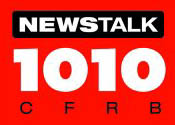 Across the border,
Astral tries rebranding venerable CFRB (1010 Toronto) as simply
"Newstalk 1010," shuffling the station's schedule in
an attempt to attract a younger audience. Across the border,
Astral tries rebranding venerable CFRB (1010 Toronto) as simply
"Newstalk 1010," shuffling the station's schedule in
an attempt to attract a younger audience.
New to the air: W237CS (95.3 Smethport PA), with news/talk
from WXMT-106.3HD2; WEVP (91.7 Laporte PA).
Call changes: WJSL (90.3 Houghton NY) to WXXY; WJOE (700 Athol
MA) to WVBB, then to WTUB. WOGF (104.3 Moon Township PA) to WOGI,
WOGI (98.3 Duquesne/Pittsburgh PA) to WOGF and then WPKV with
its new "K-Love" format; WPKV (90.7 Nanty Glo PA) to
WPAI, flipping from K-Love to "Air 1" Christian rock.
New calls: WSFS (89.3 Freehold NJ).
Gone for good: CIGM (790 Sudbury ON), at 5 PM Sept. 30; CKRU
(980 Peterborough ON).
 OCTOBER: A
week after the big WQXR move, Univision Radio relaunches its
new purchase, New York's 96.3 FM, at 6 AM Oct. 15 as Spanish
hits "X 96.3," WXNY, quickly rocketing past longtime
competitor WSKQ-FM in the ratings. OCTOBER: A
week after the big WQXR move, Univision Radio relaunches its
new purchase, New York's 96.3 FM, at 6 AM Oct. 15 as Spanish
hits "X 96.3," WXNY, quickly rocketing past longtime
competitor WSKQ-FM in the ratings.
CBS Radio finishes its move to Hudson Street on Oct. 9, with
the last broadcast from the dank basement in Astoria, Queens
that was home for 22 years to WFAN.
 Greater Media doesn't
stick with top-40 "Now" on Philly-market WNUW (97.5
Burlington NJ), flipping that signal to sports on Oct. 9 as "97.5
the Phanatic," WPEN-FM and sending PD Jules Riley packing. Greater Media doesn't
stick with top-40 "Now" on Philly-market WNUW (97.5
Burlington NJ), flipping that signal to sports on Oct. 9 as "97.5
the Phanatic," WPEN-FM and sending PD Jules Riley packing.
While ESPN gets an FM home in Philly, it also finds a new
part-time home on AM in Boston, landing on WEEI (850) for overnights
and weekends - and a new full-time home in southern New Hampshire,
returning to WGAM (1250 Manchester)/WGHM (900 Nashua) after a
three-year absence.
In Syracuse, Leatherstocking flips new purchase WFBL (1390
Syracuse) from oldies to talk, sending the oldies down the dial
to WSEN (1050 Baldwinsville).
On TV, Vermont's Marselis "Div" Parsons signs off
from WCAX-TV after 42 years, most recently as news director and
evening anchor. Another veteran of many decades, Dale Dorman,
quietly signs off his most recent radio gig, doing weekends on
Boston's WODS.
Call changes: WAMO/WAMO-FM (860 Millvale/106.7 Beaver Falls
PA) to WAOB/WAOB-FM, WEMR (88.7 Dushore PA) to WAMO; WHJB (1600
Bedford) to WAYC.
New calls: WWOM (88.1 Ellwood City PA).
New to the air: CKXS (99.1 Wallaceburg ON), at 9 AM Oct. 20;
WXLS (88.3 Tupper Lake NY).
 NOVEMBER: The
biggest headlines come from the biggest markets, as New York's
"Pulse" goes through its last days, soon replaced by
a simulcast of "Party" WPTY (105.3 Calverton-Roanoke
NY, where the venerable WDRE calls are retired) and as WGBH takes
over classical WCRB at month's end. NOVEMBER: The
biggest headlines come from the biggest markets, as New York's
"Pulse" goes through its last days, soon replaced by
a simulcast of "Party" WPTY (105.3 Calverton-Roanoke
NY, where the venerable WDRE calls are retired) and as WGBH takes
over classical WCRB at month's end.
Nassau's New Hampshire ownership shuffles move "Hawk"
classic rock off WNNH (99.1 Henniker) and WWHQ (101.5 Meredith),
and over to WLKZ (104.9 Wolfeboro) on Nov. 4, leaving 99.1 and
101.5 with loops of promos for other Nassau stations and occasional
simulcasts.
CBS extends "Sports Hub" WBZ-FM (98.5 Boston) into
Hartford via WTIC-FM-HD3 - and it brings its WFAN (660 New York)
programming down to Florida, adding relays on FM HD3 channels
in Orlando, Tampa and West Palm Beach.
In the Hudson Valley, Clear Channel flips country WRWC (99.3
Ellenville) to news-talk as WKIP-FM; the WRWC calls and country
format replace news-talk on sister WELG (1370 Ellenville). On
Long Island, the LMA of WNYG (1440 Babylon) ends, with the station
set to go silent for good in early 2010. And in the Bronx, Yankees
fans celebrate championship #27, the first ever to be called
on radio by a female color commentator, WCBS' Suzyn Waldman.
Country fans in the greater Toronto area lose a powerful voice
on Nov. 13, as Corus flips "Country 95.3" (CING Hamilton)
to classic hits.
"Corm and the Coach" return to Burlington's airwaves
via new WNMR (107.1 Dannemora NY).
 An FM translator
launches with Spanish in the Hartford market, as Red Wolf Broadcasting
puts Spanish hits "La Bomba" on W248AB (97.5 Bolton)
and nominal primary WMRQ-HD2 (104.1 Waterbury). An FM translator
launches with Spanish in the Hartford market, as Red Wolf Broadcasting
puts Spanish hits "La Bomba" on W248AB (97.5 Bolton)
and nominal primary WMRQ-HD2 (104.1 Waterbury).
In southern Rhode Island, Chris DiPaola closes on his $350,000
purchase of WXNI (1230 Westerly), flipping the station to AC
as WBLQ. (Former WBLQ-LP 96.7 Ashaway RI becomes WYME-LP with
religion.)
On TV, Philadelphia's beloved weatherman Dave Roberts (who
was Buffalo's "Dave Thomas" before moving to WPVI in
1978) announces his retirement after more than half a century
on the air.
And Christmas format flips hold off until Nov. 2, with Syracuse's
WZUN and Utica's WUMX first to the punchbowl. (Technically, New
Jersey's WEZW is first, with a pre-Halloween flip, but that appears
to be stunting in advance of a brand-new format on that Cape
May signal in the new year.)
Call changes: WGSM (107.1 Greensburg) to WHJB, at least on
paper; WJOW (105.9 Philipsburg PA)/WZYY (106.9 Renovo PA) to
WQCK/WQKK, WDRE (105.3 Calverton-Roanoke NY) to WPTY.
New calls: WRQV (88.1 Ridgway PA).
Back on the air: WCLX (102.9 Westport NY), with eclectic "Farm
Fresh Radio" programmed by Chip and Kathy Morgan of WMUD-LP
(89.3 Moriah NY).
New to the air: CJWF (95.9 Windsor ON), at 8 AM Nov. 16.
DECEMBER: Curtis Sliwa, longtime voice at WABC (770
New York), signs with competitor WNYM (970 Hackensack NJ) for
a morning show to start in January, while John Batchelor takes
over Sliwa's former evening shift on WABC.
In central New York, Craig Fox and Sam Furco rearrange their
signals, flipping "Movin'" WMVN (96.7 Oswego) to "Wolf"
WWLF-FM, and changing the calls of "Movin'" WMVU (100.3
Sylvan Beach) to WMVN. Over in Rochester, students at the Rochester
Institute of Technology make headlines in a feud with community
DJs at WITR (89.7 Henrietta), which ends up mostly on automation
- and occasionally in dead air - over the holiday vacation.
In Watkins Glen, a tower collapse Dec. 14 at WRCE (1490) kills
one tower worker and puts the station off the air.
 In northeast PA, Bold Gold flips
WPSN (1590 Honesdale) from sports to CNN news, with a new FM
translator to simulcast. Near Philadelphia, Great Scott pulls
the plug on WPAZ (1370 Pottstown) Dec. 10, leaving eight people
without work. In northeast PA, Bold Gold flips
WPSN (1590 Honesdale) from sports to CNN news, with a new FM
translator to simulcast. Near Philadelphia, Great Scott pulls
the plug on WPAZ (1370 Pottstown) Dec. 10, leaving eight people
without work.
On TV, Tribune's WTIC-TV (Channel 61) and WTXX (Channel 20)
move into new digs shared with their sister newspaper, the Hartford
Courant, now under common management with the TV stations.
In New Hampshire, the end of local programming at WZMY (Channel
50) threatens the job of Al Kaprielian, prompting a movement
among his fans to save the quirky weatherman's job. Across the
border, Max Keeping announces his retirement from Ottawa's CJOH
after 51 years on the job, the last 37 at CJOH.
Down the road from the TV station, a 14-year-old kid named
Jayhaed Saade becomes a cult hero after putting a high-powered
pirate station, "Mix 91.9," on the air from the roof
of his father's strip club; after defying Industry Canada for
several weeks, Saade shuts the station down and announces he's
pursuing a broadcast license.
New to the air: CJEU (1670 Gatineau QC), testing.
Silent: WPAZ (1370 Pottstown PA), on Dec. 10; WRJI (91.5 East
Greenwich RI).
Back from the dead: WAMG (890 Dedham-Boston) with a loop of
Spanish-language music.
New calls: WRUN (1150 Utica NY) to WUTI; WREQ (96.9 Ridgebury
PA) to WZKN.

Year-End Rant (Abbreviated
Version)
Some years deserve a lengthy exegesis. To others, we simply
say "good riddance" and look toward the future. 2009
was definitely one of the latter years.
And everything we could have spent paragraphs writing about
was more ably summarized by my good friend Dennis Jackson in
a year-end quote he offered to my colleague, competitor and friend
Tom Taylor:
The fruits of deregulation are now clear — Everyone
loses. That’s the listening public, investors, lenders,
advertisers, and thousands of broadcasters who once made radio
great and were fired from jobs to which they were dedicated.
For the most part, corporate radio is a hollow, bloodless shell
replacing a medium that listeners once cared deeply about. Perhaps
2010 will be the year when real broadcasters are let back into
their stations and we can begin to turn our medium around before
it’s too late.
To which we can only say: amen.

And as we do every year, we close out our Year in Review by
remembering the many great radio and TV people our region lost
in 2009.
In Memoriam
This was a particularly painful year on that account, too,
especially at the national level, where we pay particular attention
to the passing of two of the all-time greats. Walter Cronkite
and Paul Harvey were among the last broadcasters left with links
to the golden age of radio, and Harvey in particular deserves
a salute for remaining active in the industry almost to his last
days.
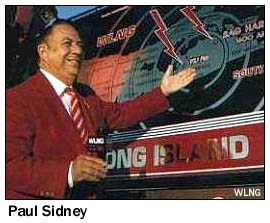 The industry lost
more than its share of local and regional legends as well: Boston's
great all-night voice, Larry Glick; Paul Sidney of WLNG, who
embodied all that was good about local radio; Phillies broadcaster
Harry Kalas, who went out in style with a World Series win; Fred
Cusick, forever the voice of the Bruins. The industry lost
more than its share of local and regional legends as well: Boston's
great all-night voice, Larry Glick; Paul Sidney of WLNG, who
embodied all that was good about local radio; Phillies broadcaster
Harry Kalas, who went out in style with a World Series win; Fred
Cusick, forever the voice of the Bruins.
From the TV world, there was Providence's Art Lake, who was
there at the start of TV in town, and Gary Papa, taken from Philadelphia
TV viewers far too young. KDKA's Fred Honsberger was taken from
Pittsburgh talk listeners far too young as well. There was George
Weber, whose brutal murder stunned the New York radio community;
Ed McMahon, who never forgot the town or the station that gave
him his start, and the list goes on (with a last-minute addition
on Christmas Eve, WFIL/WABC late-night "King" George
Michael, gone at 70 after a long fight with cancer.)
- JOHN BLAKE, 69, Long Island engineer (Dec. 26, 2008)
- VALERIE LETARTE, 47, Radio-Canada "275-ALLO" host
(Dec. 28, 2008)
- KEVIN COLLINS, Jr., 24, New Jersey and Binghamton DJ (Dec.
28, 2008)
- EMILY HOFFMAN, 53, New York radio news anchor (Jan. 5)
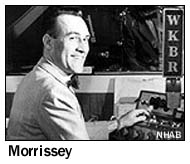 BILL
MORRISSEY, 84, longtime WKBR Manchester morning man (Jan. 8) BILL
MORRISSEY, 84, longtime WKBR Manchester morning man (Jan. 8)
- ANDRIA HALL, 51, former WCVB Boston "Chronicle"
reporter (Jan. 12)
- TIM WHITE, 49, Buffalo DJ (Jan. 13)
- MIKE McCOY, Binghamton DJ (Jan. 15)
- KENNY YOUNGS, 83, central NY DJ (Jan. 24)
- R.D. SUMMERS (THOMAS RENKENBERGER), 60, WWSW Pittsburgh DJ
(Feb. 15)
- JOHN KANZIUS, 64, former WJET Erie VP/GM (Feb. 18)
- HARRISON RIDLEY, 70, WRTI Philadelphia jazz DJ (Feb. 19)
- DON RIGGS, 81, WPXI Pittsburgh announcer (Feb. 21)
- PAUL HARVEY, 90 (Feb. 28)
 NELSON DOAK, 60,
WKTJ Farmington ME co-owner (March 1) NELSON DOAK, 60,
WKTJ Farmington ME co-owner (March 1)
- TOD JEFFERS, 67, Pennsylvania talk host (March 1)
- STEVE AMIRAULT, 62, Merrimack Valley PD (March 2)
- FRANK FORD (ED FELBIN), 92, longtime Philadelphia talker
(March 3)
- THOMAS T. GOLDSMITH, 99, DuMont engineering guru (March 5)
- BRIAN JAMES, 48, voiceover talent, ex-WBZZ Pittsburgh (March
6)
- GEORGE ROSSI, 75, Binghamton GM (March 5)
- JOHN "ROMAN" DOMANSKI, 55, ex-WKXW PD (March 8)
- JOHN B. HILL, 60, WVBR Ithaca engineer (March 12)
- MIKE "SPYDER" McGUIRE, 55, Jersey Shore DJ (March
15)
- BRIAN SMITH, 52, CHWO/CFZM DX coordinator (March 19)
- BILL "MARSHALL" GRAVINO, WVLT PD, WTMR ops manager
(March 19)
- GEORGE WEBER, WABC newsman (March 20)
- LEN WOLOSON, 79, WARM Scranton DJ (March 22)
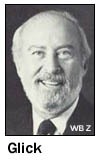 LARRY GLICK, 87,
WBZ overnight talk legend (March 26) LARRY GLICK, 87,
WBZ overnight talk legend (March 26)
- PAUL SIDNEY, 69, WLNG GM emeritus (April 2)
- FRECKLES, 13, NERW Wonder Dog (April 3)
- HOWARD CLARK, 70, WWDJ jock (April 6)
- GARDNER HILL, 62, WKXL Concord NH talk host (April 12)
- HARRY KALAS, 73, legendary Phillies broadcaster (April 13)
- LES KEITER, 89, NYC sportscaster (April 14)
- MERLE HARMON, 82, Jets broadcaster (April 15)
- BILL CORBEIL, 40, WTSA Brattleboro owner (April 19)
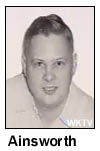 MERV
AINSWORTH, 83, WKTV Utica chief engineer (April 19) MERV
AINSWORTH, 83, WKTV Utica chief engineer (April 19)
- KAREN YOURD LASH, 51, ex-WDAD/WQMU Indiana PA jock (April
21)
- LES WALTON, 52, CKTB St. Catharines news director (April
23)
- ERIK SELBY, 43, KQV PD (April 27)
- HARRY ABRAHAM, 64, WHAM jazz jock (May 7)
- PAUL GRIMES, 61, Scranton DJ (May 14)
- AL RACCO, 80, ex-WABC GM (May 20)
- RANDY STEELE, 47, CHCH Hamilton reporter (May 22)
- R. CLARK WITT IV, 32, former Utica board op (May 24)
- JIM "LORD" CHAMPLAIN, ex-WTRY jock/production director
(May 25)
- JEN "KING" COUDREY, ex-WRRB/WRRV DJ (May 29)
 STEVE BULL, 54,
WKTJ Maine operations manager (May 30) STEVE BULL, 54,
WKTJ Maine operations manager (May 30)
- GENE GARNES, Sr., 81, NBC engineer (June 5)
- ANALOG TV, 70-ish, veteran broadcast technology (June 12)
- DON ZIHLMAN, 61, ex-WLAM host (June 12)
- BOB LAWRENCE, 80, WGBB PD (June 12)
- ART CERVI, 89, Erie-market station owner (June 14)
- MICHAEL BERNZ (CIPRIANI), 58, CT/RI DJ (June 18)
- GARY PAPA, 54, WPVI sports director (June 19)
- KEN ROBERTS, 99, New York announcer (June 19)
- ED McMAHON, 86, WLLH Lowell radio veteran who made it big
(June 23)
- IRV HOMER, 86, Philly talker (June 24)
 CLEO "DON"
BROOKS, 68, NJ station owner (June 27) CLEO "DON"
BROOKS, 68, NJ station owner (June 27)
- MARTIN STREEK, 45, ex-CFNY Toronto jock (July 6)
- TUCK STADLER, 87, WINS newsman (July 10)
- BRAD SHERMAN, 83, WINS newsman (July 12)
- WALTER CRONKITE, 92 (July 17)
- WARREN DOOLIN, 71, WNAC/WHDH-TV/WCVB photojournalist (July
20)
- BILL CUSACK, 76, WXKS, WPLM DJ (July 21)
- LES LYE, 84, CJOH announcer (July 21)
- MARGARET JONES, 62, ex-WYNY/WHN DJ (July 21)
 GEORGE TAYLOR MORRIS,
62, veteran Boston DJ/PD (Aug. 1) GEORGE TAYLOR MORRIS,
62, veteran Boston DJ/PD (Aug. 1)
- JAMES HAZELTINE III, 67, "Jim Rivers" on WLAN/WIBG
(Aug. 1)
- IRA APPLE, 74, WBZ, KDKA, WBAL PD (Aug. 11)
- CHRIS "GABLE" BOROD, 56, WYNY/WMGK jock, WRKZ PD
(Aug. 12)
- CHUCK AZZARELLO, 60, CHEZ Ottawa founding PD (Aug. 22)
- GEORGE NEHER, 65, WWNY Watertown PD/morning man (Aug. 25)
- EGIDIO "ED" POLICASTRI, 84, former WPRO AM-FM chief
engineer (Sept. 1)
 SHARON FOGAREN,
43, WFHN morning co-host (Sept. 2) SHARON FOGAREN,
43, WFHN morning co-host (Sept. 2)
- JIM WHITE, 85, ex-KDKA, KMOX talker (Sept. 4)
- HILARY BOGDEN, 85, WJAS Pittsburgh announcer (Sept. 5)
- DALE LANE, 62, Albany DJ (Sept. 5)
- JERRY BARSHA, 83, WSYR/WSTM investigative reporter (Sept.
10)
- FRED SHERMAN, 86, KYW newsman (Sept. 12)
- JACK FREDERICKS, 84, WKTV Utica announcer (Sept. 14)
- FRED CUSICK, 90, legendary Bruins voice (Sept. 15)
- PAULINE YATES, 84, WCAP station manager (Sept. 19)
- STEVE "MR. MOVIE" FRIEDMAN, 62, Philadelphia talker
(Sept. 20)
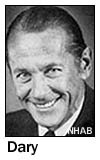 ALAN DARY, 89, Boston/NH
DJ (Oct. 2) ALAN DARY, 89, Boston/NH
DJ (Oct. 2)
- JOHN "MR. MAGIC" RIVAS, NYC hip-hop DJ (Oct. 2)
- "DIAMOND" JIM NETTLETON, legendary Philadelphia
DJ (Oct. 4)
- DONALD A. THURSTON, 79, Berkshire Broadcasting owner (Oct.
5)
- MARK OLDS, 88, WWRL/WRVR GM (Oct. 8)
- BOB ELLSWORTH, 83, WTIC anchor, WJMJ DJ (Oct. 9)
- HANK SPANN, WWRL DJ (Oct. 14)
- RICHARD GLADWELL, 88, WXXI "With Heart and Voice"
host (Oct. 15)
- BRUCE CHARLES, 85, WNEW newsman (Oct. 16)
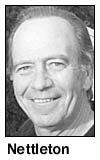 SOUPY SALES, 83,
TV comedian and WNBC host (Oct. 21) SOUPY SALES, 83,
TV comedian and WNBC host (Oct. 21)
- BILL CHADWICK, 94, NY Rangers announcer (Oct. 24)
- BOB APPELL, 52, ex-WSFW DJ (Nov. 3)
- STANLEY MIASTKOWSKI, 58, ex-WHMP DJ (Nov. 3)
- TED TEFFNER, 69, WCAX engineer extraordinaire (Nov. 12)
- DANIEL W. KOPS, Sr., 92, CT station owner (Nov. 14)
- DENE HALLAM, 56, former WHN/WKHK PD (Nov. 20)
- ART LAKE, 85, WJAR weatherman for 60 years (Nov. 22)
- NAT WRIGHT, 82, WIP overnight jock (Nov. 26)
- AL ALBERTS, 82, WPVI talent show host (Nov. 27)
- JOHN "SIR WALTER RALEIGH" CHRISTIAN, 92, Pittsburgh
DJ, newsman (Nov. 29)
- HAROLD "HAL" FULMER III, 69, PA station owner (Dec.
3)
- PAUL JEFFERS, 75, ex-WCBS,WINS news director (Dec. 4)
- BOB GESSNER, 86, WBNR, WSGO/WGES owner (Dec. 5)
- JACK DALY, ex-CKOY/CKBY sports director, GM (Dec. 8)
- PAUL GODOFSKY, 91, WHLI/WKJY founder (Dec. 11)
- FRED HONSBERGER, 58, KDKA talk host (Dec. 16)
- JIM GENOVESE, 61, Long Island DJ (Dec. 16)
- GEORGE MICHAEL, 70, WFIL/WABC jock-turned-sportscaster (Dec.
24)
- MICHAEL MANCINI, 44, Cox Radio New Haven salesman (Dec. 25)
- PERCY SUTTON, 89, Inner City Broadcasting founder/owner (Dec.
26)
- DAVE MOCK, 41, CBS Radio News producer/reporter (Dec. 27)

NorthEast Radio Watch is made possible by the generous
contributions of our regular readers. If you enjoy NERW, please
click here to
learn how you can help make continued publication possible. NERW
is copyright
2009 by Scott Fybush. |

